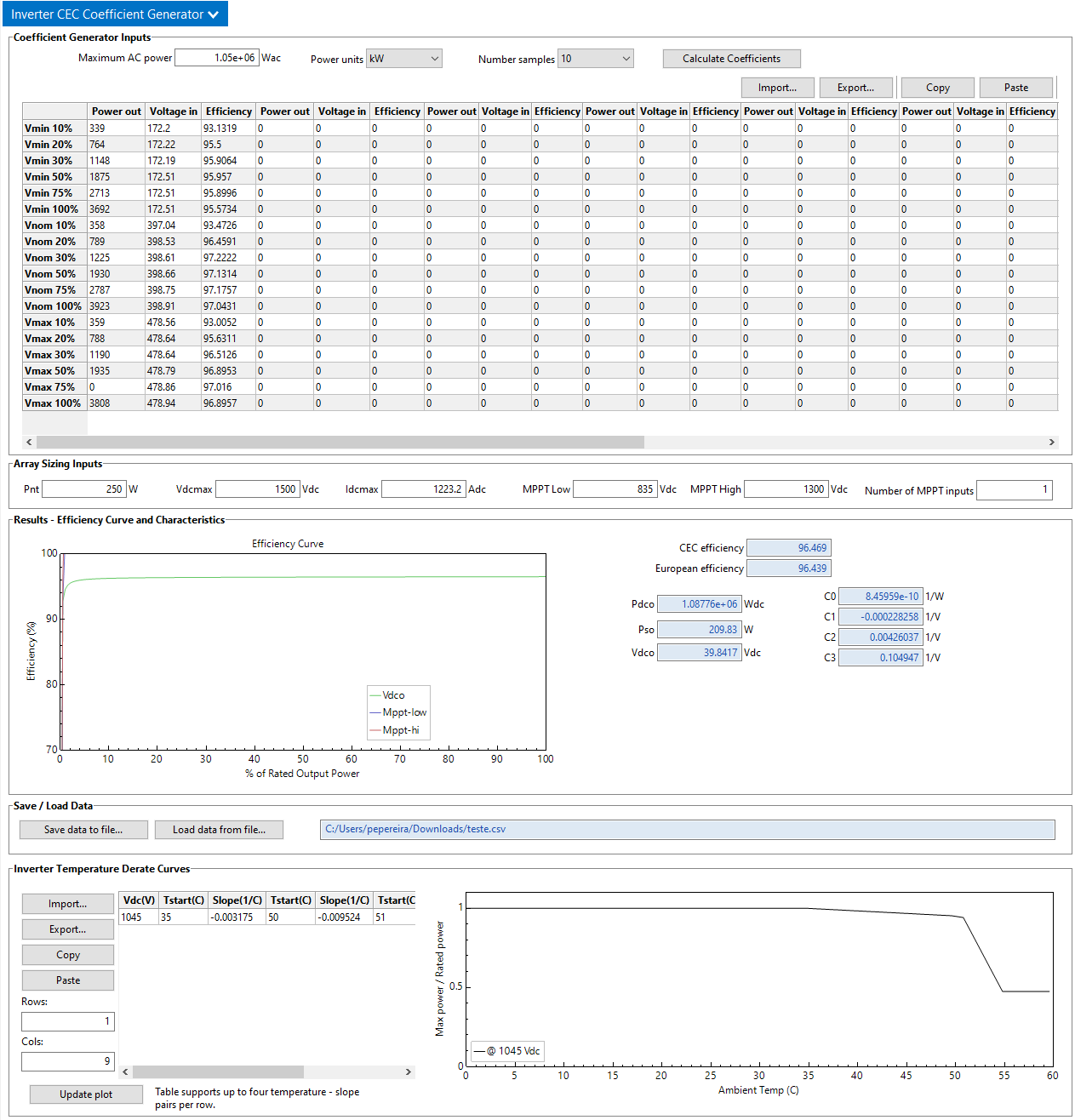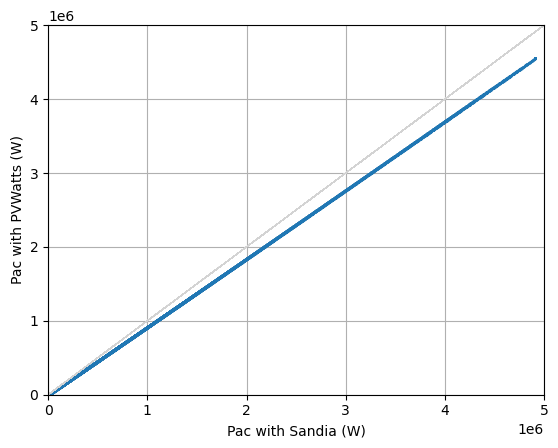Create custom inverter on PVlib: GE 1500V 1.1MW inverter (LV5-1511-30-IEC-SLR)
Pedro
Will Hobbs
Pedro

Pedro
cwh...@sandia.gov
Cheers,
import pandas as pd
import pvlib
import matplotlib.pyplot as plt
ac_power = np.array([339., 764., 1148., 1875., 2713., 3692.,
358., 789., 1225., 1930., 2787., 3923.,
359., 788., 1190., 1935., np.nan, 3808.]) * 1000 # Watts
effic = np.array([93.1319, 95.5, 95.9064, 95.957, 95.8996, 95.5734,
93.4726, 96.4591, 97.2222, 97.1314, 97.1757, 97.0431,
93.0052, 95.6311, 96.5126, 96.8953, 97.016, 96.8957]) # percent
dc_power = ac_power / (effic / 100.)
dc_voltage = np.array([172.2, 172.22, 172.19, 172.51, 172.51, 172.51,
397.04, 398.53, 398.61, 398.66, 398.75, 398.91,
478.56, 478.64, 478.64, 478.79, 478.86, 478.94])
dc_voltage_level = ['Vmin']*6
dc_voltage_level.extend(v for v in ['Vnom']*6)
dc_voltage_level.extend(v for v in ['Vmax']*6)
dc_voltage_level = np.array(dc_voltage_level)
names = ['ac_power', 'dc_power', 'dc_voltage', 'dc_voltage_level']
data = pd.DataFrame.from_dict(dict(zip(names, [ac_power, dc_power, dc_voltage, dc_voltage_level])))
data.dropna(inplace=True)
p_ac_0 = 1050000 # Watts
p_nt = 250 # Watts
params = pvlib.inverter.fit_sandia(
data['ac_power'], data['dc_power'], data['dc_voltage'],
data['dc_voltage_level'], p_ac_0, p_nt)
sim = pvlib.inverter.sandia(data['dc_voltage'], data['dc_power'], params)
eff = sim / data['dc_power'] * 100
plt.figure()
for v in ['Vmin', 'Vnom', 'Vmax']:
x = sim[data['dc_voltage_level']==v] / p_ac_0 * 100
y = eff[data['dc_voltage_level']==v]
plt.plot(x, y, label=v)
plt.legend(['Vmin', 'Vnom', 'Vmax'])
Pedro
cwh...@sandia.gov
Pedro
Hey Cliff,
Anton Driesse
Hi Pedro,
There are some functions for fitting the ADR model in:
https://github.com/adriesse/pvpltools-python/blob/master/pvpltools/power_conversion.py
Currently it is geared toward just translating the SAPM parameters, but the translation goes via a table of values. If you run the function "create_cec_matrix_sandia" you'll see the format needed for this table. Then just substitute your data into that table structure and run the tail end of the function "fit_adr_to_sandia" (the portion after the call to "create_cec_matrix_sandia".
Anton
--
You received this message because you are subscribed to the Google Groups "pvlib-python" group.
To unsubscribe from this group and stop receiving emails from it, send an email to pvlib-python...@googlegroups.com.
To view this discussion on the web visit https://groups.google.com/d/msgid/pvlib-python/32546602-8968-4a40-b571-3b99a84d2cd6n%40googlegroups.com.
-- Photovoltaic Performance Labs Germany Emmy-Noether-Str. 2 79110 Freiburg Germany +49-761-8973-5603 (Office) +49-174-532-7677 (Mobile) www.pvperformancelabs.com
Pedro
Anton Driesse
Hi Pedro,
Sorry, I was not completely clear. You can run
"create_cec_matrix_sandia" using any inverter from the database to
see what the data structure is. Then replicate this data
structure using the information you have. (You wrote: "I do have
some curves", so I am assuming you have what you need for this.)
Anton
To view this discussion on the web visit https://groups.google.com/d/msgid/pvlib-python/c6bb4845-8113-4367-a967-2e8559be2cd9n%40googlegroups.com.
-- PV Performance Labs Germany Emmy-Noether-Str. 2 79110 Freiburg Germany
salazar...@gmail.com
I also have an .OND file like Pedro, from there I took the data of three curves that appear in the sections ProfilPIOV1=TCubicProfile (although I don't know what they are, it seems to me that they are DC and AC power data, respectively), and I tried to adjust these values to the code that Cliff shared with us. I attached the.OND file and code.
dc_voltage_level = ['Vmin']*n
dc_voltage_level.extend(v for v in ['Vnom']*n)
dc_voltage_level.extend(v for v in ['Vmax']*n)
dc_voltage_level = dc_voltage_level
'dc_power': np.array([87520.0, 172720.0, 343090.0, 513280.0, 854520.0, 1282560.0,
88160.0, 173310.0, 343860.0, 515790.0, 856510.0, 1285160.0,
89060.0, 174070.0, 344670.0, 515210.0, 857730.0, 1286600.0]),
'ac_power': np.array([84439.3, 168868.3, 337737.8, 506607.4, 844351.2, 1266528.0,
84439.6, 168873.3, 337739.3, 508001.6, 844347.6, 1266525.2,
84437.8, 168865.3, 337742.1, 506606.0, 844349.4, 1266529.0]),
'dc_voltage': [939.0, 939.0, 939.0, 939.0, 939.0, 939.0,
1061.0, 1061.0, 1061.0, 1061.0, 1061.0, 1061.0,
1170.0, 1170.0, 1170.0, 1170.0, 1170.0, 1170.0],
'dc_voltage_level': dc_voltage_level
}
p_ac_0 = 1520*1000 # Watts
p_nt = 90.00 # Watts
data = pd.DataFrame(dict2)
dc_power=data['dc_power'],
dc_voltage=data['dc_voltage'],
dc_voltage_level=data['dc_voltage_level'],
p_ac_0=p_ac_0,
p_nt=p_nt)
What causes me doubt is that the results of the Pdco and Pso parameters are not what I expected according to the .OND file, and therefore I do not know if the parameters C0, C1, C2 and C3 are correct. Is there any way I can do this validation?
Thanks in advance.
Nelson A. Salazar Pena
cwh...@sandia.gov
import numpy as np
import pandas as pd
import pvlib
import matplotlib.pyplot as plt
fig = plt.figure()
labels = []
for v in np.unique(data['dc_voltage']):
labels.append(str(v) + "V")
labels.append('')
u = data['dc_voltage'] == v
p = plt.plot(data['dc_power'][u], data['eff'][u] * 100, '.')
plt.plot(data['dc_power'][u], data['pred_eff'][u] * 100,
color=p[0].get_color())
labels = labels[0:-1:2]
plt.xlabel('Total DC power (W)')
plt.ylabel('Efficiency (%)')
plt.legend(labels, loc='lower center', ncol=3)
plt.tight_layout()
return fig
data['eff'] = data['ac_power'] / data['dc_power']
data['pred_eff'] = data['pred_ac_power'] / data['dc_power']
fig = compare_efficiency(data)
fig.show()
salazar...@gmail.com
I'm taking Pdco = PNomDC*1000 and Pso = Pthresh or Pso = 1% of Pdco (per PVsyst documentation here). Also, according to this PVsyst documentation, I understand that the curve I mentioned is the DC Power vs AC Power (they use it to calculate the inverter efficiency). I am taking Pso = 0.5% of Pdco (i.e., 8615 W) and the function fit_sandia indicates a value of 3219 W. It seems to me that for the capacity of the inverter this result is good, but I do not have metrics to say it with certainty.
Unfortunately I do not have real data to check, but attached I share a curve where I compare the results between Sandia's AC model and NREL PVWatts. The results show that with Sandia the values are lower, and that is also expected. For example, I got these statistical metrics:


Does this look like a good result or may I be missing something?
Thanks for sharing the code for the plot of efficiency vs DC power, it is excellent and I also see it according to the nominal values of the .OND file. I think it is useful to have this function in pvlib or to have it available in an example, because it is not easy for an agent to have the information obtained from this plot (agents would have to ask the manufacturer for it and I am not sure that they have it easily available either). It can also help to understand the operation of the inverter from the weighted efficiency calculation by viewing these curves.
cwh...@sandia.gov
salazar...@gmail.com
Ok, thanks for the clarification. I will check because other tests I have done agree with the approximate 1.5% difference you mention. It could also be due to the values in the .OND file, some of them also seem strange to me. Any news I will tell you.
The good news is that it does seem possible (and feasible) to estimate the parameters C0, C1, C2 and C3 from an .OND file.
Orçun Başlak
Inverter AC Output (PVLIB_FIT_SANDIA) : 70,208.8kWh
#######
#######
Inverter AC Output (SANDIA_DATABASE) : 76,522.8kWh
#######
#######
Inverter AC Output (PVSYST) : 76,672.5kWh
#######
#######
Inverter AC Output (ADR) : 70,155.1kWh
Michael Morris
To view this discussion on the web visit https://groups.google.com/d/msgid/pvlib-python/c9fcf127-f82c-4dfb-ad92-b4c6c204bc21n%40googlegroups.com.
